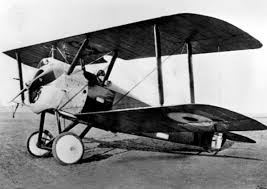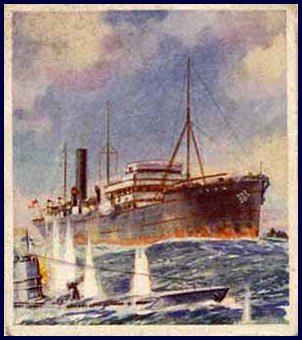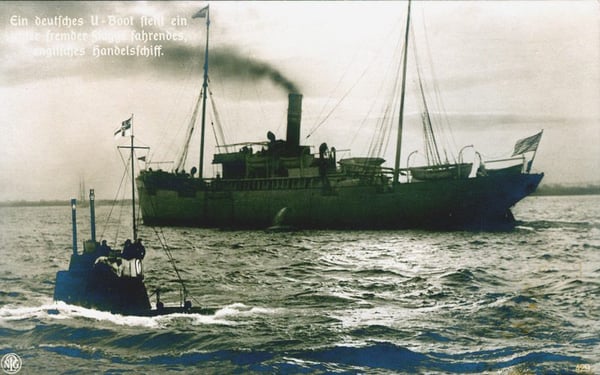From 1914 – 1918, humanity experienced the global conflict we now refer to as World War One. The rise of industrial capabilities and a wide range of technological advances, enabled "The Great War" to become one of the deadliest conflicts in history. WW1 has been described as the clash between 20th-century technology and 19th-century tactics. The significant advances in war machines on the sea, air and land created seemingly unstoppable weapons of mass destruction on every front. After suffering the horrifying effects of these newly devised technologies, both sides scrambled to provide a response. In some cases, new technologies were quickly developed, and in others new tactics were employed. This is a look at the rise of U-Boat technology and the resulting Q-Ship tactics used to counter their effectiveness.




The U-Boat Threat
At the start of WWI, each side attempted to disrupt the ocean supply routes of the other. The British Royal Navy was considered the strongest in the world, and indeed its surface ships were able to over-power those of the opposing German Empire. Britain used its ships to blockade Germany and was very successful in keeping the German surface fleet in port. Out of necessity, the Germans expanded their tactics to include attacking British supply ships using their technologically superior submarine fleet of Undersea Boats (Unterseeboote) – also known as U-Boats.
At the time, the only offensive Anti-Submarine Warfare (ASW) tactic was to simply wait for subs to surface and then attack them as you would a ship. Once a submarine dove beneath the surface it vanished like a ghost. John Holland who designed the US Navy's first commissioned submarine, wrote in 1900 that "the submarine is indeed a 'sea-devil,' against which no means we possess at present can prevail."
A collection of passive tactics were used against submarines, as no offensive means existed. Torpedo nets were still hung off the sides of vessels, although the increased speed of newer torpedoes limited their effectiveness. Anti-Torpedo Bulges were also added to ships, which created a protective compartment of water on either side of the ship’s hull. Both these tactics could be beaten however, by firing several torpedoes at the same location. Innovative “Dazzle Camouflage” was also tried in response to the extreme need to counter U-Boats. The Dazzle Camouflage was designed confuse rather than conceal, by disrupting a giant ship's outline. When viewing a vessel through a submarine periscope the Dazzle Camouflage made it difficult to estimate the ship's range, speed, and heading. Without this vital information, a torpedo could not be launched accurately and would miss its target.
Anti-Torpedo Bulge
Dazzle Camouflage
In response to the continued success of the British blockade, Germany ordered its U-Boats to conduct unrestricted submarine warfare as a "military necessity" and attack British merchant ships in addition to combat vessels. The Allies were surprised by this tactic, as they didn't think civilized nations would use subs to attack unarmed supply ships in such an "ungentlemanly" fashion.
In May 1915 the German submarine U-20 torpedoed the civilian ocean liner RMS Lusitania, which Germany claimed was also carrying supplies. Of the 1,959 civilian passengers and crew aboard the Lusitania at the time of her sinking, 1,195 were lost at sea. Many of the bodies recovered in the Irish Sea were buried in the Navy port town of Queenstown Ireland (now Cobh). While most Americans saw the war as a dreadful mistake and were determined to stay out, this incident was considered an unforgivable affront to humanity, and finally helped convince America to enter the World War to "make the world safe for democracy".
The Q-Ship Response
During World War One, Winston Churchill served as the First Lord of the Admiralty for the British Navy and proposed a new ASW tactic to respond to the “Submarine Menace”. He advocated expanding the practice of using armed vessels disguised as civilian supply ships. These ships would trick U-Boats into surfacing and moving closer, where they could then be attacked and destroyed.

As U-Boats had a limited number of torpedoes (8-12 per boat), they often saved them to attack British combat vessels and would surface to attack vulnerable supply ships with their deck guns. If a Navy ship could fool a U-Boat to surface and come near enough, it would lose its advantage and could be destroyed. This method of attacking subs had been used before, but not as an organized military tactic.
In the Navy these stealthy “Mystery Ships” also became known as Q-Ships. The name was derived from the port they mainly operated from, namely Queenstown Ireland (now Cobh). The Q-Ships depended on secrecy for their survival. It could be said that just as a submarine relies on the murky ocean depths to maintain its stealth, the Q-Ships used a cloak of deception to hide in plain sight.

After the concept of using Q-Ships was adopted, the challenge became finding the perfect type of merchant ship to use. Too small a ship could not fit the crew needed to attack a U-Boat, nor would it have the power to maneuver in combat. However, too big a ship that could not be boarded, might just be torpedoed without the U-Boat risking drawing near. In the end, a “three-islands” tramp steamer ship such as the HMS Penshurst was considered best. It was a common ship used in the area, and could hold a crew of 100 officers, seamen, and marines. It was a tempting target for U-Boats to disable and plunder. While the tramp steamer might have been best suited, many sorts and sizes of mystery ships where actually used.

The tramp steamer sized Q-Ships typically had an array of weapons that might include heavy 12-pound guns, smaller 6 and 3-pounders, modern 4-inch guns, and Maxim machine guns. Some ships such as the HMS Farnborough also carried simple depth charges. These offensive weapons were concealed with elaborate disguises to render them invisible until needed.
The ability for a Q-Ship to appear as a civilian supply vessel or fishing boat was the most important factor to their success. The crew itself wore no military clothing and adopted costumes that fit the civilian roles they were playing, namely civilian travelers, fishermen, or merchant mariners. They were ordered to behave in an "un-military" way onboard and in general appear sloppy, unprepared, and an easy target. The exact number of the crew on the ship was also kept a secret, so the enemy would think they did not have the manpower to defend themselves. Marines would hide during voyages and only appear through hidden trap doors when the attack had begun. The Q-Ships would also change their names and flags to match the public records of commercial ships in the area.
There was no specific overall plan on how the Q-Ships should prepare their disguises and entrap U-Boats. The elaborate level of deceptions each boat created was a testament to the ingenuity of their captains and the discipline of their crews. Many vessels secretly employed skilled craftsman to build false or dummy structures and other devices that masqueraded the Q-Ships' true nature. Most Q-Ships crews preformed elaborately acted scenes when U-Boats were spotted, to feign distress or otherwise demonstrate they were not a threat. If an enemy submarine was sighted, the Q-Ships showed an effort to escape, but would in the end allow them selves to be overpowered. They used deceptions to conceal their true strength, such as setting smoky fires to simulate mechanical breakdowns, or by having some of the crew dress as woman to reinforce their non-aggressive civilian status.
A common Q-Ship tactic was also to wait until a sub was close enough to attack, then give up and deploy a “panic party”. This was a charade where members of the crew pretended to be afraid and abandoned the ship in lifeboats. After this “panic crew” had fled and the ship seemed empty to the U-Boat, it was hoped that the sub would draw nearer to board or use its light guns. At this point the ship would raise their true (Royal Navy) flag, the hidden crew would magically appear on deck, and false panels would drop to reveal the blazing deck guns.
An example of the ingenious methods
used to hide the Q-Ship guns.
A 12-pounder was mounted inside a
dummy row boat, that split open to fire.
Of course, luring the most deadly sea creature nearer to you was very risky. The U-Boats would often torpedo and shoot at the ships to make sure they were actually disabled and abandoned. Some Q-Ships purposely navigated into the path of an incoming torpedo, just to lure the submarine closer. Due to this practice of allowing the U-Boat to attack and cause damage, some ships were reinforced with extra buoyant materials to keep them from sinking too fast. The hidden Q-Ship crew would need to keep their cool during these attacks and suffer their injuries quietly, until the submarine was close enough to trap. It took a special kind of sailor to calmly wait while having their ship destroyed around them - and still be ready to hit back at the right moment. In the end about 25 ships and many sailors were lost. The story of the HMS Stock Force is a good example of the courage needed to serve on a Q-Ship.
The Effect of Q-Ships
The Q-Ships enjoyed some combat success in the beginning. All in all, perhaps their greatest success was the psychological effect they had. On the British side, they helped bolster morale by demonstrating a response to the “unstoppable” U-Boat threat. In reality despite their glamour and creativity, of all the 180 Q-Ships in service only 10 saw combat, and only 14 U-Boats were destroyed. That gives them an even lower success rate than static sea mines. While these numbers seem low, it's fair to speculate that several German U-Boat commanders decided against attacking seemingly defenseless boats, because of the Q-Ship threat. By reducing possible U-Boats damage, the Q-Ships may well have saved many lives.
The Q-Ships also became infamous after the Baralong Incident in August 1915, where a Q-Ship captain was accused of murdering a defeated U-Boat crew. Many of the Baralong's crew were deeply affected by the search for survivors of the RMS Lusitania in May, and by the attack on the ocean liner SS Arabic earlier that day. The captain claimed his actions were justified after the sinking of the Lusitania, and that the U-Boat crew still presented a danger. Not only did the incident raise awareness of the existence of Q-Ships for the Germans, the “British atrocity” also served to justify the practice of torpedoing civilian supply ships without getting too close and allowing the crew to disembark. It's worth noting that the Germans also objected to the fact that Q-Ship crews fought out of uniform, and labeled them as "francs tireurs", that is as guerrilla fighters who operate outside the laws of war. Because of this designation, it was rumored that Q-Ship crews would also be shot and not captured.
By the final months of 1917, the effective use of Q-Ships was basically over. The end of the Q-Ships was ironically due in part to their early success. The Q-Ship depended on deception to be effective, and as their fame (or infamy) grew, they conversely became less effective. Commanders of U-Boats had become keenly aware of these "U-Boot-Falle" (trap ships) and their disguises, and were no longer fooled into coming too close.
The Q-Ships bought some time however, for the Allied Powers to develop new ASW technologies and tactics that proved much more effective in stopping U-Boats. Echo-ranging technology, Seaplanes, and improvements in depth charge design and production, became the best way to find and destroy subs. In addition, the defensive tactic of shipping convoys proved very effective, where if one ship was attacked, all the others in the convoy would respond.

The “War to End All Wars” featured a unique mix of old and new technologies and tactics. The meme of cavalry on horseback bravely charging newly created armored forces, is an inspiring example of human spirit in the face of overwhelming odds. The bravery and ingenuity shown by Q-Ship crews, who lured U-Boat sailors into their traps, should likewise be remembered. History has shown that advances in technology often demand such daring new tactics, and in turn new tactics then inspire new technologies. This is especially true in the ongoing evolution of Submarine warfare.






